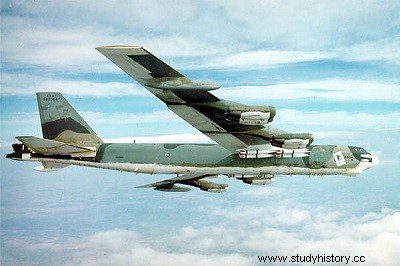
The logistical supply from the United States was provided by freighters, and by the Military Airlift Comma (MAC) fleet composed mainly of C-141 Star lifters; the C-130s provided most tactical transport operations, showed a rare efficiency in this work.
A considerable fleet of helicopters, especially from the U.S. Army, ensured the supply of the battlefield, the evacuation of the wounded and the repatriation of planes or any other salvageable damaged vehicles. Importantly, increasingly throughout the war, helicopters played a role in the battle itself. The Huey was the most employed; the CH-47 Chinook carried out heavy transport, particularly of damaged aircraft, a job in which it was soon supplanted by the CH-54 Skycrane ("sky crane") for the heaviest loads.
The Hughes OH-6 Cayuse, a light observation aircraft, was ordered in large numbers. Lockheed began in 1966 its studies on the AAFSS (Advanced Aerial Fire Suppression System) which resulted in the extraordinary AH-56 Cheyenne; this attack helicopter, capable of approaching 400 km/h, powerfully armed, was as complicated and almost as expensive as the B-52! These two elements easily explain its abandonment.
Instead of the expected orders from Cheyenne, the Huey-Cobra (attack version) was built in the thousands, although the opponents of this solution have always declared this two-seater far too expensive and vulnerable to enemy fire under certain conditions. angles.
The Viet Cong learned to hide when the helicopters approached, then to come out when they left empty-handed:classic guerrilla tactics. But there was a sovereign weapon against which nothing could be done, the most hated weapon:the B-52.
The first Stratofortress models (B-52D and B-52F) were camouflaged:the upper surfaces in irregular green and brown, the lower surfaces in matte black. They were launched into battle in June 1965 from Guam, and in May 1966 from Thailand. The B-52s dropped torrents of fire, each device capable of carrying up to 108 bombs (24 of 370 kg and 84 of 245 kg).
They intervened at very high altitudes and dropped their bombs based on electronic locations. There was no sound to warn of the arrival of the B-52s or their attack; they were mostly invisible, in any case never identifiable.
Thus the Viet Cong was constantly under the threat of a deluge of bombs that they neither heard nor saw coming. The morale of the Communist troops suffered considerably. On several occasions, fighter-bombers intervened in the same way as the B-52s, dropping their bombs from altitudes above 5000 m; B-66s served as FAC scouts. Various versions of B-66 accompanied more and more often the raids on North-Vietnam, and especially versions ECM of electronic warfare. A fleet of KC135s provided air-to-air refueling for fighters and attack planes below bingo — without enough fuel to get home.
Reconnaissance missions were carried out by many types of aircraft. The most advanced was the RA-5C Vigilante. Operating from aircraft carriers, it could carry out electronic surveillance of the target as well as provide complete coverage of large sectors of South or North Vietnam. Tactical reconnaissance was entrusted to the RF-4C Phantom and the RF-101 Voodoo. The OV-1 Mohawk was primarily concerned with battlefield surveillance; this STOL device received special systems, SLAR (Side-Looking Aircraft Radar) and MTD (Moving Target Detection) to illuminate and fix the most minimal objectives, such as a moving man. Electronic reconnaissance and jamming became increasingly important as North Vietnamese capabilities grew. Many types of aircraft were loaded with it:RB-57, RA-3B Skywarrior, EA-6A Prowler (a special version of the A-6 Intruder), EB-66 and even RC-47 Dakota — decidedly good for all missions !...
